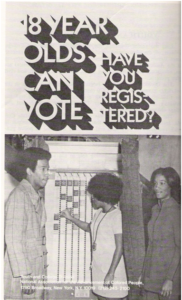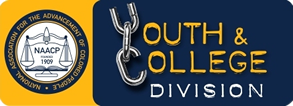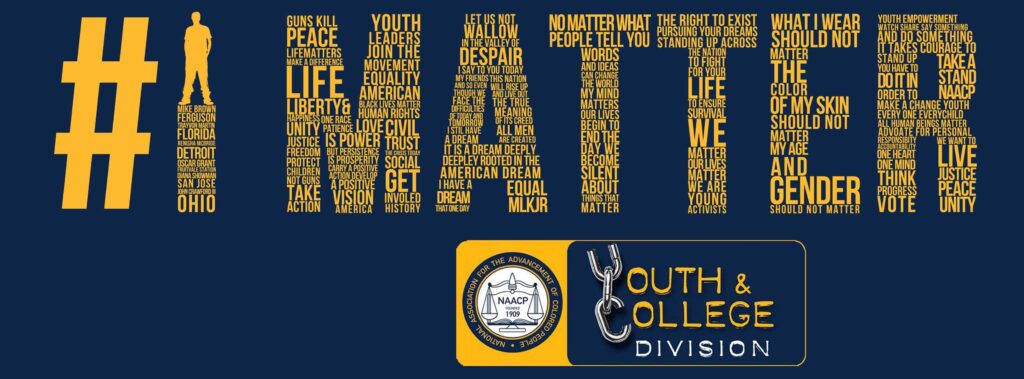1934-1937: Building the Foundation

The NAACP’s official organ, The Crisis Magazine, carried information on young people and encouraged formation of youth units for a number of years before any action was taken to form a division in the Association devoted to youth activities. In 1935, during the St. Louis Convention, a fiery address was made by one of the youth delegates, Miss Juanita Jackson, to create a department for youth.
Subsequently, on September 15, 1935, Miss Jackson joined the Association’s staff and became the first Youth Secretary. The NAACP National Board of Directors passed a resolution formally creating the Youth and College Division in March of 1936. Under the guidance of Ms. Jackson, a National Youth Program was created for youth members of the NAACP. This program provided national activities for youth that were supported by monthly meetings discussing local needs of the community. The major national youth activities were demonstrations against lynching and seminars and group discussions on the inequalities in public education.
At the historical first youth meeting in Baltimore, Maryland, June 29 – July 4, 1936, 217 youth delegates held a national conference simultaneously with adult members. Delegates outlined a national program that addressed four major areas: equal educational opportunities, equal economic opportunities, civil liberties, and physical security against lynching. The new plan called for the scrapping of what was then known as the junior branch with the old age limits of 14 – 21 years old for youth members. This was replaced by junior youth councils, ages 12 –15, youth councils, ages 16 – 25, including college youth and college units, and the creation of a youth program similar to that of the adults.
This spirit of solidarity among black youths was sparked by years of racial discrimination, segregation, and mob violence. “Flesh and blood and the breath of life must be added to the skeleton we have constructed,” declared youth member, Edward A. Lawrence in an article in the September, 1936 edition of The Crisis. The year was marked by an increasingly aggressive and efficient level of activity within youth units, indicating not only intelligent leadership and loyalty on the part of the members; but a laudable spirit of cooperation among the young people.
Under the guidance of Miss Jackson, a national youth program evolved. This program, built around the major objectives of the Association, provided for national periodic youth activities that were supported through monthly youth programs addressing local needs. The major national youth activities were mass meetings against inequalities in public education and demonstrations against lynching was evidenced in December, 1934 when Howard University Students organized and picketed a national Conference in Washington, DC when leaders refused to discuss lynching as a national crime. This demonstration led to congress enacting the Federal Anti-lynching Bill.
1950-1970: The Fight for Equality and Justice
In the 1950’s, the Virginia State NAACP College Chapter was recognized for its leadership in the sit-ins in the city of St. Petersburg. The College Chapters of Indiana and Wilberforce succeeded in getting several local restaurants to serve Negro patrons while the NAACP College Chapter at Florida A&M was financially contributing to the Tallahassee bus protest.
In 1955, the Division sponsored the second annual National Youth Legislative Conference, which met for three days in February in Washington, DC to discuss the role that young people could play in helping to break down racial discrimination and segregation.
In 1956, the Division took an active role in encouraging letters of protest in the treatment of black student, Autherine Lucy, at Alabama University. As a result of this pressure, student officers in the university passed a resolution calling upon the administration to admit Miss Lucy and urging students not to participate in further demonstrations against her.
In 1958, division units in Wichita, Kansas and Oklahoma City, Oklahoma, set the tone for the civil rights movement of the sixties by launching the first of many sit-in demonstrations at lunch counters and other public places to protest their second class citizenship. That same year the NAACP awarded its coveted Spingarn Medal to nine black teenagers who dared to break the color line at their local high school in Little Rock, Arkansas.
During the 1960’s, heightened activity by division units challenged all facets of discrimination. Division units conducted sit-ins, stand-ins, drive-ins, wade-ins, read-ins, mass demonstrations, protest marches, picket lines and selective buying campaigns in the South, Midwest and in virtually every other section of the country. They attended conferences, workshop sessions and rallies; they helped line up students to apply for transfers to integrated schools; and they assisted in voter registration drives.
The year 1961 saw Division units reach an all-time high in civil rights action. During the year, units:
- led the first sit-ins to take place in the state of Mississippi at Jackson (March 9);
- integrated 42 new places of public accommodations in Oklahoma City including the John A. Brown Department Store;
- shifted the emphasis of sit-ins from public accommodations to the area of jobs; led a successful “selective buying” campaign in Durham, North Carolina, where more than 100 new job opportunities were made available to Negro wage earners;
- ended discrimination in off-campus housing against black students at Rutgers University; and
- established active chapters at the following predominantly white institutions of higher learning in the south: Duke University, University of North Carolina and the University of Oklahoma; marking the first time since 1948 that the Association was able to organize and gain formal recognition at such institutions in the south.
For black Americans, especially for members of the “New Generation”, 1969 was a year of unparalleled civil rights activity. Young people shouted and demonstrated for an end to inequality for blacks and other oppressed people, particularly in economics, education, politics and cultural survival. The members of the Division, under the direction of James Brown, Jr., were in the midst of such activities. In many communities, they provided the catalyst that stimulated the uncovering and correction of many wrongs. The division pursued with vigor four basic objectives: (1) to inform youth of the problems affecting black and other minority groups; (2) to advance the economic, educational, social and political status of black people and other minority groups; (3) to stimulate an appreciation of the black contribution to civilization; and (4) to develop an intelligent and militant youth leadership through devising, working out and pursuing local programs.
1980-1990s: Continuing the Struggle
Priority for the Division in the 80’s was voter registration and mobilization. Registration efforts in the northeast were intense. Division units conducted registration drives in shopping centers, subway stations, cheese lines and other public places. The Over-ground railroad was a three-phase project whose major goal was to stamp out voter apathy and encourage voter participation. This project was one that included youth and adults who walked from northern to southern California, throughout the Midwest, in the south and on the east coast.
During the 1990’s, the Youth and College Division focused attention on the glaring disparities that continued to exist in the United States. In 1991 and 1992, youth units in the south, particularly in Mississippi, mobilized thousands of community members to address unequal educational opportunities for Black students and to advocate for the survival of Historically Black Colleges and Universities. In 1996, the National Day of College Preparation was created in partnership with The Princeton Review Foundation as a means to present college preparation skills and financial aid information to high school students and parents. In an effort to address youth violence in the black community, the “Stop the Violence, Start the Love” Campaign was created under the direction of Rev. Jamal Harrison Bryant in 1997.
2000-2005: “Renewed Youth Activism”
Beginning in 2000, the Youth & College Divisions ushered in a renewed spirit of leadership and activism in the NAACP. Notable events during this period included:
- South Carolina Youth & College Division helped lead the largest march in the south since the height of the civil rights movement, with over 100,000 people participating in their King Day at the Dome mobilization in 2000.
- In 2001, death threats against black students at Penn State prompted an extended sit-in organized by the Penn State College Chapter and supported by NAACP college units from Howard University.
- In 2002, membership and leadership development within the Division were on-going and expanding, as the Phoenix Project was created under the leadership of Jeffery Johnson as a way to engage young people in juvenile detention facilities.
- The National Take Affirmative Action Day was created in 2002 as a vehicle for young people to become engaged in the fight to protect this much needed policy.
- Youth units across the country mobilized in 2003 to call for the release of Marcus Dixon – an 18 year old African American honor student in Rome, Georgia who was convicted to ten years in prison for having consensual sex with a white classmate who was just three months shy of her 16th birthday. As a result of the Youth and College Division national efforts, under the direction of Brandon T. Neal, the Georgia Supreme Court overturned Marcus Dixon’s conviction.
2006-2011: “The New Front Line”
Under the direction of Stefanie L. Brown, the Youth & College Division continues to be one of the strongest and most capable elements in the NAACP. Through the implementation of the Division’s VOTE HARD youth civic engagement campaign in 2008, over 50,000 young people have been registered to vote. Additional highlights during this time period include:
- Thousands of NAACP youth members from around the nation rallied at the steps of the United States Supreme Court in advance of the court’s decision on the Gratz v. Bollinger case, regarding the University of Michigan’s undergraduate affirmative action admissions policy in 2006.
- In 2007, youth units mobilized from across the country to Jena, Louisiana to march against the excessive punishment against six African American boys. In the same year, the Georgia Youth & College Division helped lead a national march in Atlanta, Georgia to keep the Voting Rights Act alive.
- The NAACP Youth & College Division condemned off-campus parties held by predominately white fraternities at Clemson University and the University of California-San Diego where students mocked African Americans and civil rights icons in derogatory manners. As a result, the Division created the Campaign to End Campus Racism in 2007.
- Texas Youth & College Division leaders mobilized students from across the state to Austin, Texas to testify against the state school board for trying to erase African American and civil rights history from public education textbooks.
- On September 15, 2010 Mississippi State Youth & College Division mobilized over a 1000 young people to the state capitol to speak out for the freedom of the Scott Sisters.
- In 2011, the North Carolina Youth & College Division mobilized thousands of young people to the state capitol in Raleigh, North Carolina to address re-segregation issues promoted by the Wake County School Board.
Since it was founded in 1909, the NAACP has provided and trained more leaders for the black community than any other secular organization. Virtually every black American leader, public and private, local and national, learned the spirit of public service and the techniques of leadership through the NAACP. Roy Wilkins, Rosa Parks, Vernon Jordan, Julian Bond, Andrew Young, Patricia Harris, Thurgood Marshall, Ralph Bunche, Dr. Ronald Walters, and many others served their apprenticeships in the Association’s youth units – including the NAACP Chairman of the Board of Directors, Roslyn M. Brock and the President and CEO, Benjamin Todd Jealous.
Today there are over 600 NAACP Youth Councils, High School Chapters and College Chapters actively involved in social justice advocacy by addressing local issues as well as a national agenda made up of problems including: Education, Economic Empowerment, Health, Juvenile Justice, and Civic Engagement. The NAACP is the only major civil rights organization, which encourages young people to participate fully in all aspects of its structure, including membership on the National Board of Directors.
 The NAACP’s official organ, The Crisis Magazine, carried information on young people and encouraged formation of youth units for a number of years before any action was taken to form a division in the Association devoted to youth activities. In 1935, during the St. Louis Convention, a fiery address was made by one of the youth delegates, Miss Juanita Jackson, to create a department for youth.
Subsequently, on September 15, 1935, Miss Jackson joined the Association’s staff and became the first Youth Secretary. The NAACP National Board of Directors passed a resolution formally creating the Youth and College Division in March of 1936. Under the guidance of Ms. Jackson, a National Youth Program was created for youth members of the NAACP. This program provided national activities for youth that were supported by monthly meetings discussing local needs of the community. The major national youth activities were demonstrations against lynching and seminars and group discussions on the inequalities in public education.
At the historical first youth meeting in Baltimore, Maryland, June 29 – July 4, 1936, 217 youth delegates held a national conference simultaneously with adult members. Delegates outlined a national program that addressed four major areas: equal educational opportunities, equal economic opportunities, civil liberties, and physical security against lynching. The new plan called for the scrapping of what was then known as the junior branch with the old age limits of 14 – 21 years old for youth members. This was replaced by junior youth councils, ages 12 –15, youth councils, ages 16 – 25, including college youth and college units, and the creation of a youth program similar to that of the adults.
This spirit of solidarity among black youths was sparked by years of racial discrimination, segregation, and mob violence. “Flesh and blood and the breath of life must be added to the skeleton we have constructed,” declared youth member, Edward A. Lawrence in an article in the September, 1936 edition of The Crisis. The year was marked by an increasingly aggressive and efficient level of activity within youth units, indicating not only intelligent leadership and loyalty on the part of the members; but a laudable spirit of cooperation among the young people.
Under the guidance of Miss Jackson, a national youth program evolved. This program, built around the major objectives of the Association, provided for national periodic youth activities that were supported through monthly youth programs addressing local needs. The major national youth activities were mass meetings against inequalities in public education and demonstrations against lynching was evidenced in December, 1934 when Howard University Students organized and picketed a national Conference in Washington, DC when leaders refused to discuss lynching as a national crime. This demonstration led to congress enacting the Federal Anti-lynching Bill.
The NAACP’s official organ, The Crisis Magazine, carried information on young people and encouraged formation of youth units for a number of years before any action was taken to form a division in the Association devoted to youth activities. In 1935, during the St. Louis Convention, a fiery address was made by one of the youth delegates, Miss Juanita Jackson, to create a department for youth.
Subsequently, on September 15, 1935, Miss Jackson joined the Association’s staff and became the first Youth Secretary. The NAACP National Board of Directors passed a resolution formally creating the Youth and College Division in March of 1936. Under the guidance of Ms. Jackson, a National Youth Program was created for youth members of the NAACP. This program provided national activities for youth that were supported by monthly meetings discussing local needs of the community. The major national youth activities were demonstrations against lynching and seminars and group discussions on the inequalities in public education.
At the historical first youth meeting in Baltimore, Maryland, June 29 – July 4, 1936, 217 youth delegates held a national conference simultaneously with adult members. Delegates outlined a national program that addressed four major areas: equal educational opportunities, equal economic opportunities, civil liberties, and physical security against lynching. The new plan called for the scrapping of what was then known as the junior branch with the old age limits of 14 – 21 years old for youth members. This was replaced by junior youth councils, ages 12 –15, youth councils, ages 16 – 25, including college youth and college units, and the creation of a youth program similar to that of the adults.
This spirit of solidarity among black youths was sparked by years of racial discrimination, segregation, and mob violence. “Flesh and blood and the breath of life must be added to the skeleton we have constructed,” declared youth member, Edward A. Lawrence in an article in the September, 1936 edition of The Crisis. The year was marked by an increasingly aggressive and efficient level of activity within youth units, indicating not only intelligent leadership and loyalty on the part of the members; but a laudable spirit of cooperation among the young people.
Under the guidance of Miss Jackson, a national youth program evolved. This program, built around the major objectives of the Association, provided for national periodic youth activities that were supported through monthly youth programs addressing local needs. The major national youth activities were mass meetings against inequalities in public education and demonstrations against lynching was evidenced in December, 1934 when Howard University Students organized and picketed a national Conference in Washington, DC when leaders refused to discuss lynching as a national crime. This demonstration led to congress enacting the Federal Anti-lynching Bill.

